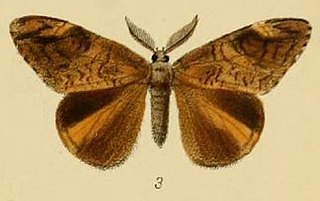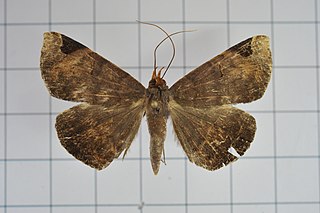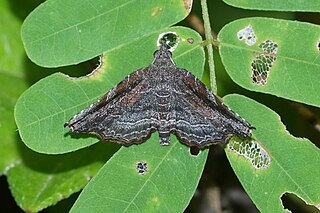Related Research Articles
Chilena is a genus of moths in the family Lasiocampidae. It was described by Francis Walker in 1855. They are distributed in Nepal, central India, and Sri Lanka.

Aroa is a genus of moths in the subfamily Lymantriinae first described by Francis Walker in 1855. Species are distributed in South Africa, China, throughout India, Sri Lanka, Myanmar, and Java.
Dunira scitula is a moth of the family Noctuidae first described by Francis Walker in 1865. It is found in Sri Lanka.
Hyperlopha cristifera is a moth of the family Noctuidae first described by Francis Walker in 1863. It is found in Sri Lanka, Laos, Malaysia and Australia. Adult wings are pale brown, sometimes with a number of dark dots near the tornus of each forewing. Forewings with a hooked wingtip, and a cusp on the margin can be found.
Maguda palpalis is a moth of the family Noctuidae first described by Francis Walker in 1865. It is found in Sri Lanka.

Mecodina praecipua is a moth of the family Noctuidae first described by Francis Walker in 1865.

Panilla dispila is a moth of the family Noctuidae first described by Francis Walker in 1865. It is found in Sri Lanka and Taiwan.

Nagadeba indecoralis is a moth of the family Noctuidae first described by Francis Walker in 1865. It is found in Sri Lanka, Java, India, Myanmar, India's Andaman Islands, Japan and Taiwan.
Radara subcupralis is a moth of the family Noctuidae first described by Francis Walker in 1866.
Tadaxa bijungens is a moth of the family Noctuidae first described by Francis Walker in 1865. It is found in Sri Lanka.
Saroba ceylonica is a moth of the family Noctuidae first described by Francis Walker in 1865. It is found in the Indian subregion, the Andaman Islands, Singapore, Sumatra, Borneo and Sri Lanka.
Saroba maculicosta is a moth of the family Noctuidae first described by Francis Walker in 1865. It is found in Sundaland, the Philippines, Papuan region to Solomon islands and Sri Lanka.
Saroba pustulifera is a moth of the family Noctuidae first described by Francis Walker in 1865. It is found in the Indian subregion, Hong Kong, Thailand, Sundaland, Sulawesi and Sri Lanka.
Bembina apicalis is a moth of the family Erebidae first described by Francis Walker in 1865. It is found in India and Sri Lanka.
Casama vilis is a moth of the family Erebidae first described by Francis Walker in 1865. It is found in Sri Lanka, India, Middle East, Ethiopia, Kenya and Somalia.
Euproctis semisignata is a moth of the family Erebidae first described by Francis Walker in 1865. It is found in India and Sri Lanka.
Lygephila dorsigera is a moth of the family Erebidae first described by Francis Walker in 1865. It is found in Sri Lanka and Taiwan.
Rabila frontalis, the red bollworm, is a moth of the family Noctuidae. The species was first described by Francis Walker in 1865. It is found in India and Sri Lanka.
Anigraea cinctipalpis is a moth of the family Noctuidae first described by Francis Walker in 1865. It is found in Indian subregion, Sri Lanka, Malaysia, Borneo, Philippines, New Guinea and Australia.
Feliniopsis opposita is a moth of the family Noctuidae first described by Francis Walker in 1865. It is found in Kenya, Somalia, Sri Lanka and India.
References
- ↑ "Species Details: Chilena strigula Walker, 1865". Catalogue of Life. Retrieved 2 March 2018.
- ↑ Koçak, Ahmet Ömer; Kemal, Muhabbet (20 February 2012). "Preliminary list of the Lepidoptera of Sri Lanka". Cesa News. Centre for Entomological Studies Ankara (79): 1–57. Retrieved 2 March 2018.
- ↑ "HOSTS - a Database of the World's Lepidopteran Hostplants". The Natural History Museum. Retrieved 2 March 2018.
| This article on a moth of the family Lasiocampidae is a stub. You can help Wikipedia by expanding it. |